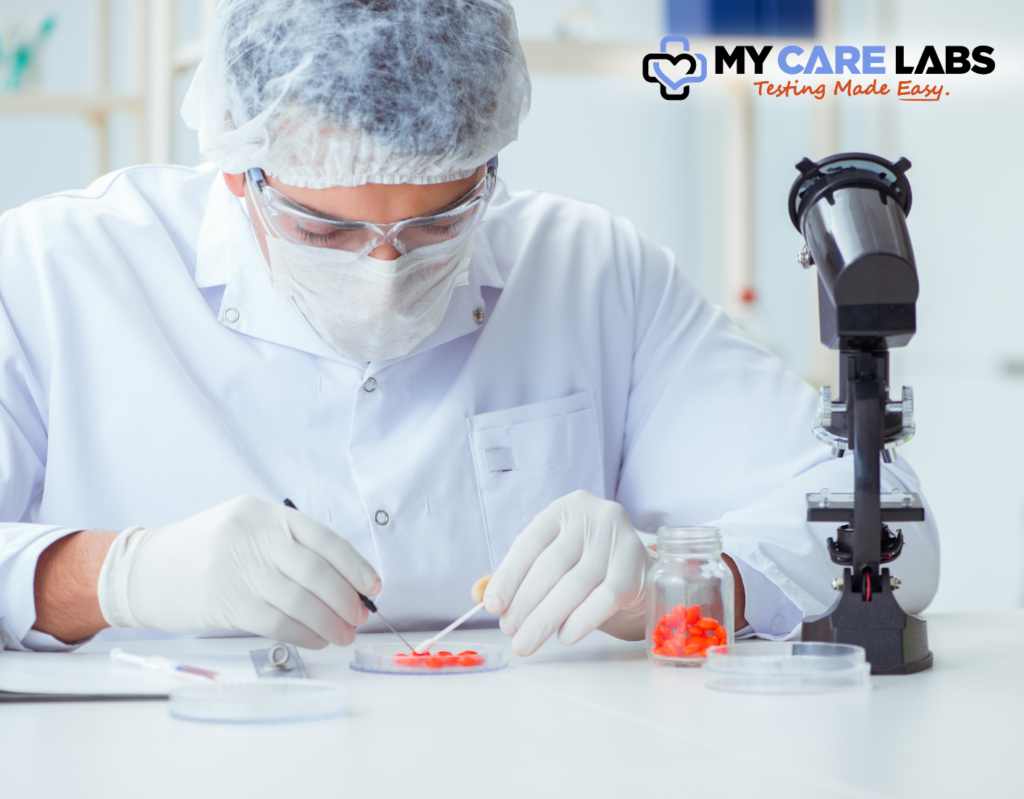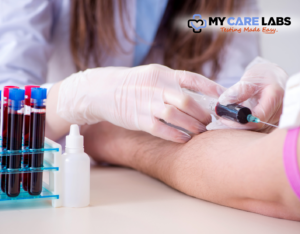Drug testing in the workplace has become increasingly important in today’s society due to the prevalence of substance abuse issues.
Employers recognize the need to implement measures to ensure the well-being of their employees and the integrity of their operations.
This guide serves as an introduction to drug testing in the workplace, shedding light on its significance and the various aspects involved.
Through this guide, we hope to empower organizations to make informed decisions regarding drug testing practices, ultimately contributing to enhanced workplace safety and employee well-being.
Trust My Care Labs to be your partner in achieving a healthier and safer workplace through effective drug testing solutions.
Understanding Drug Testing in the Workplace:
Definition and Background:
- Drug testing in the workplace refers to the process of screening employees or job applicants for the presence of drugs or alcohol in their system.
- It has been implemented by organizations as a preventive measure to address substance abuse issues among employees.
- The practice of drug testing in the workplace gained prominence in the 1980s as companies recognized the negative impact of substance abuse on productivity and safety.
Importance for Maintaining a Safe and Productive Work Environment:
- Drug testing plays a crucial role in ensuring workplace safety by identifying employees who may be impaired while on duty.
- It helps prevent accidents, injuries, and potential harm to employees and others in the workplace.
- Maintaining a drug-free workplace promotes productivity and efficiency as employees are less likely to experience impaired performance due to substance use.
Legal Implications and Regulatory Considerations:
- Drug testing in the workplace is subject to various legal regulations at the federal, state, and local levels.
- Employers must comply with laws such as the Drug-Free Workplace Act and the Americans with Disabilities Act (ADA) when implementing drug testing policies.
- Regulations dictate the types of tests that can be conducted, how they are administered, and the rights of employees regarding privacy and consent.
Role in Promoting a Drug-Free Workplace Culture:
- Drug testing acts as a deterrent to substance abuse among employees, promoting a culture of accountability and responsibility.
- It sends a message to employees that drug use is not tolerated in the workplace, fostering a sense of trust and professionalism.
- By identifying and addressing substance abuse issues early on, employers can support employees in seeking help and rehabilitation, ultimately contributing to a healthier work environment.
Drug testing in the workplace serves as a proactive measure to safeguard the well-being of employees and the integrity of the organization. By understanding its definition, importance, legal considerations, and role in promoting a drug-free culture, employers can implement effective drug testing policies that contribute to a safe and productive work environment.
Benefits of Drug Testing in the Workplace:
Ensuring Workplace Safety and Security:
- Drug testing helps identify employees who may be under the influence of drugs or alcohol while on duty, thereby reducing the risk of workplace accidents and ensuring overall safety.
- By detecting and addressing substance abuse issues early on, employers can create a safer working environment for all employees.
Preventing Accidents and Injuries:
- Impaired employees pose a significant risk of causing accidents and injuries in the workplace, not only to themselves but also to their colleagues.
- Drug testing acts as a preventive measure by identifying individuals who may be unfit for work due to substance use, thereby reducing the likelihood of workplace incidents.
Deterring Drug Abuse:
- The prospect of undergoing drug testing serves as a deterrent to drug abuse among employees.
- Knowing that they may be subject to random or pre-employment drug screenings encourages employees to refrain from using illicit substances, contributing to a healthier work environment.
Promoting Employee Health and Well-being:
- Drug testing can help identify employees who may be struggling with substance abuse issues and connect them with appropriate resources and support services.
- Early intervention through drug testing can facilitate access to treatment and rehabilitation programs, promoting the physical and mental well-being of employees.
Protecting Company Reputation and Liability:
- A drug-free workplace enhances the reputation of the company as a safe and responsible employer.
- By implementing drug testing policies, organizations demonstrate their commitment to maintaining a professional and productive work environment, which can positively impact their public image and brand reputation.
- Additionally, drug testing helps mitigate the risk of legal liabilities associated with workplace accidents or incidents caused by impaired employees.
Drug testing in the workplace offers numerous benefits, including enhancing safety, preventing accidents, promoting employee health, and safeguarding the reputation and liability of the organization. By prioritizing drug testing as part of their workplace policies, employers can create a more secure, productive, and supportive work environment for their employees.
Random Drug Testing in the Workplace
Random drug testing in the workplace is a proactive measure taken by employers to ensure safety, productivity, and compliance. Here are some key points regarding random drug testing in the workplace:
- Purpose: Random drug testing is conducted without prior notice to employees to deter drug use and promote a drug-free workplace environment.
- Safety: By implementing random drug testing, employers aim to minimize the risk of accidents, injuries, and other safety incidents caused by impaired employees.
- Compliance: Random drug testing helps employers comply with legal and regulatory requirements related to workplace safety and drug-free policies.
- Deterrence: The unpredictability of random drug testing serves as a deterrent against drug use among employees, reducing the likelihood of substance abuse in the workplace.
- Fairness: Random drug testing ensures fairness among employees, as it applies to all individuals within the organization regardless of their job role or tenure.
- Confidentiality: Employers must maintain confidentiality and privacy throughout the random drug testing process to protect the rights and dignity of employees.
- Frequency: Random drug testing should be conducted at regular intervals to maintain its effectiveness and deterrence value.
- Education: Employers should educate employees about the purpose and procedures of random drug testing to foster understanding and cooperation.
- Consequences: Clearly communicate the consequences of failing a random drug test, including disciplinary actions and potential termination, to reinforce the seriousness of the policy.
- Support: Offer support resources for employees struggling with substance abuse issues, including access to counseling, rehabilitation programs, and employee assistance programs (EAPs).
Random drug testing in the workplace is a proactive approach to maintaining a safe, productive, and drug-free work environment. By implementing this practice, employers can promote employee well-being, protect company assets, and comply with legal and regulatory standards.
Types of Drug Tests Used in the Workplace:
Urine Drug Tests:
- Urine drug tests are among the most common methods used for workplace drug screening.
- This type of test detects the presence of various drugs or their metabolites in the urine sample.
- Urine drug tests are cost-effective, non-invasive, and provide reliable results for a wide range of substances.
- They are typically administered as part of pre-employment screening, random testing, or post-accident investigations.
Saliva Drug Tests:
- Saliva drug tests, also known as oral fluid tests, involve collecting a saliva sample from the individual’s mouth.
- These tests are relatively quick and easy to administer, making them suitable for on-site testing.
- Saliva drug tests can detect recent drug use, typically within the past 24 to 48 hours, depending on the substance.
- They are commonly used for roadside drug testing and in workplaces where immediate results are required.
Hair Follicle Drug Tests:
- Hair follicle drug tests involve analyzing a small sample of hair to detect drug use.
- This type of test can detect drug metabolites that have been incorporated into the hair shaft over time, providing a longer detection window compared to urine or saliva tests.
- Hair follicle drug tests can detect drug use for up to 90 days or even longer, depending on the length of the hair sample collected.
- They are often used for pre-employment screening or in situations where a longer history of drug use needs to be assessed.
Blood Drug Tests:
- Blood drug tests involve drawing a blood sample from the individual’s vein to detect the presence of drugs or alcohol.
- These tests provide accurate and reliable results, particularly for detecting recent drug use and determining the level of impairment.
- Blood drug tests are commonly used in post-accident investigations or for medical purposes, such as monitoring drug levels in individuals undergoing treatment for substance abuse.
Breathalyzer Tests for Alcohol:
- Breathalyzer tests, also known as breath alcohol tests, measure the concentration of alcohol in a person’s breath.
- These tests are primarily used to detect recent alcohol consumption and determine the individual’s blood alcohol concentration (BAC).
- Breathalyzer tests are non-invasive and provide immediate results, making them suitable for roadside testing and on-the-spot assessments of impairment.
- They are widely used in workplaces where alcohol use is prohibited or where employees are required to operate machinery or vehicles safely.
Various types of drug tests are used in the workplace to detect drug and alcohol use among employees. Each type of test has its advantages and limitations, and employers may choose the most appropriate method based on their specific needs, regulatory requirements, and the desired detection window.
Implementing Drug Testing Programs in the Workplace:
Developing Comprehensive Drug Testing Policies and Procedures:
- Employers should establish clear and comprehensive drug testing policies outlining the purpose, scope, and procedures of the program.
- These policies should define the types of drugs being tested for, the frequency of testing, and the consequences of positive results.
- It is essential to ensure that drug testing policies comply with relevant laws and regulations governing workplace drug testing.
Educating Employees about Drug Testing Protocols and Expectations:
- Employers should provide employees with information about the company’s drug testing program, including when and how testing will be conducted.
- Employees should be educated about the consequences of drug use in the workplace, as well as their rights and responsibilities regarding drug testing.
- Clear communication about drug testing protocols helps to promote transparency and reduce confusion among employees.
Establishing Protocols for Administering Drug Tests:
- Employers should establish clear protocols for administering drug tests, including the collection of samples, testing procedures, and chain of custody requirements.
- It is essential to ensure that drug testing is conducted in a professional and respectful manner, respecting the privacy and dignity of employees.
- Employers may choose to use third-party testing providers to administer drug tests, ensuring impartiality and accuracy in the testing process.
Training Staff and Designated Testing Administrators:
- Staff members responsible for administering drug tests should receive comprehensive training on testing procedures, sample collection, and chain of custody protocols.
- Designated testing administrators should be trained to handle sensitive information with discretion and maintain confidentiality throughout the testing process.
- Training programs should also include education on recognizing signs of substance abuse, providing support to employees, and referring individuals to appropriate resources for assistance.
Ensuring Confidentiality and Privacy Protection:
- Employers must take steps to safeguard the confidentiality and privacy of employees undergoing drug testing.
- This includes ensuring that drug test results are kept confidential and accessible only to authorized personnel involved in the testing process.
- Employers should also implement appropriate security measures to protect sensitive information related to drug testing, such as secure storage of test results and records.
Implementing a drug testing program in the workplace requires careful planning, clear communication, and adherence to legal and ethical standards.
By developing comprehensive policies and procedures, educating employees, and ensuring confidentiality and privacy protection, employers can effectively implement drug testing programs to promote a safe and drug-free work environment.
Challenges and Considerations in Drug Testing in the Workplace:
Addressing Employee Privacy Concerns and Legal Rights:
- One of the primary challenges in drug testing in the workplace is balancing the need for drug screening with employees’ rights to privacy.
- Employers must navigate complex legal frameworks governing workplace drug testing, including laws related to employee privacy, discrimination, and disability rights.
- It is essential to communicate openly with employees about the purpose and procedures of drug testing, addressing any concerns they may have about privacy and confidentiality.
- Employers should also ensure that drug testing policies and procedures comply with applicable laws and regulations to avoid legal challenges and disputes.
Managing Costs and Resources for Drug Testing Programs:
- Implementing a drug testing program in the workplace can be costly, requiring investments in testing equipment, personnel training, and administrative resources.
- Employers must carefully consider the financial implications of drug testing and allocate resources effectively to ensure the sustainability of the program.
- Cost-effective strategies, such as outsourcing drug testing to third-party providers or implementing random testing schedules, can help manage expenses while maintaining program effectiveness.
- Employers should also weigh the potential costs of drug-related incidents in the workplace, such as accidents, injuries, and productivity losses, against the expenses of implementing a drug testing program.
Dealing with False Positives and False Negatives:
- False positive and false negative results are inherent risks of drug testing and can have significant implications for both employees and employers.
- False positive results occur when a drug test incorrectly indicates the presence of drugs or substances that the individual has not consumed.
- False negative results occur when a drug test fails to detect the presence of drugs or substances that the individual has consumed.
- Employers must establish protocols for handling and verifying positive test results to minimize the risk of false positives and false negatives.
- Regular quality control measures, such as confirmatory testing and review by medical professionals, can help mitigate the impact of false results on employees’ rights and workplace safety.
Ensuring Accuracy and Reliability of Drug Test Results:
- The accuracy and reliability of drug test results are critical factors in maintaining the credibility and effectiveness of a drug testing program.
- Employers must ensure that drug testing procedures follow established protocols and adhere to industry standards for accuracy and reliability.
- Regular calibration and maintenance of testing equipment, as well as ongoing training for testing personnel, are essential to minimize errors and inconsistencies in test results.
- Employers should also stay informed about advancements in drug testing technology and best practices to continually improve the accuracy and reliability of their drug testing programs.
Addressing challenges and considerations in drug testing in the workplace requires a proactive and strategic approach.
By prioritizing employee privacy rights, managing costs effectively, minimizing the risk of false results, and ensuring the accuracy and reliability of drug test results, employers can implement drug testing programs that promote safety, productivity, and compliance in the workplace.
Drug Testing Policies in the Workplace
Drug testing policies in the workplace play a crucial role in ensuring safety, productivity, and compliance. Here are key points regarding drug testing policies in the workplace:
- Purpose: Drug testing policies in the workplace are established to maintain a safe and drug-free environment for employees, customers, and visitors.
- Legal Compliance: These policies are designed to comply with relevant federal, state, and local laws and regulations governing drug testing in the workplace.
- Scope: Drug testing policies outline the types of drug tests that may be conducted, such as urine, saliva, hair follicle, blood, or breathalyzer tests, and the circumstances under which they may be administered.
- Employee Consent: Policies typically require employees to consent to drug testing as a condition of employment or as specified in the organization’s employment policies.
- Confidentiality: Policies emphasize the importance of maintaining confidentiality and privacy throughout the drug testing process to protect employees’ rights and dignity.
- Testing Procedures: Policies detail the procedures for administering drug tests, including the collection, handling, and transportation of specimens, as well as the testing methodology and laboratory protocols.
- Consequences: Policies specify the consequences of testing positive for drugs, which may include disciplinary actions, such as suspension, termination, or referral to rehabilitation programs.
- Education and Training: Employers provide education and training to employees about the purpose and procedures of drug testing, as well as the potential consequences of drug use in the workplace.
- Non-Discrimination: Policies prohibit discrimination against employees based on the results of drug tests and ensure fairness and equal treatment for all employees.
- Review and Update: Drug testing policies are periodically reviewed and updated to reflect changes in laws, regulations, industry standards, and organizational needs.
Drug testing policies in the workplace are essential for promoting safety, compliance, and fairness.
By establishing clear and comprehensive policies, employers can create a supportive environment that prioritizes the well-being and security of all employees.






